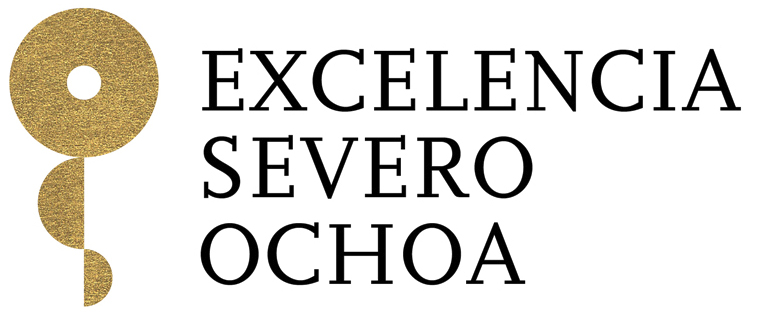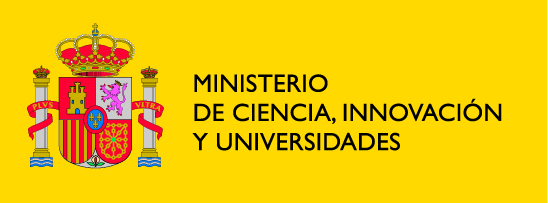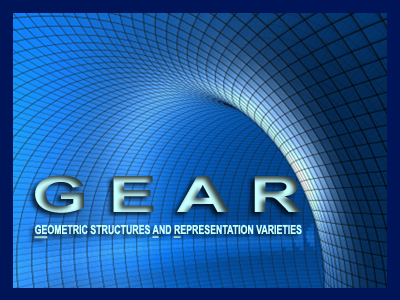Schedule
| Monday 10 | Tuesday 11 | Wednesday 12 | Thursday 13 | Friday 14 | |
| 10:30 - 11:30 | Anna Fino | Andriy Haydys | Conan Leung | Andriy Haydys | |
| 11:30 - 12:00 | Registration (until 12:30) and Coffee Break |
Coffee Break | Coffee Break | Coffee Break | Coffee Break |
| 12:00 - 13:00 | Marisa Fernandez | Thomas Walpuski | Ziming Ma | Philip Candelas | |
| 13:00 - 15:00 | Lunch | Lunch | Aleksander Doan (13:05-14:05) | Lunch | Lunch |
| Lunch | |||||
| 15:00 - 16:00 | Claude LeBrun | Joel Fine | Free afternoon | Xenia de la Ossa | |
| 16:00 - 16:30 | Coffee Break | Coffee Break | Coffee Break | ||
| 16:30 - 17:30 | Dietmar Salamon | Dietmar Salamon | Challenger Mishra | ||
| 20:15 | Social Dinner |
Programme
Click here to download the scientific programme.
Titles and Abstracts
- Philip Candelas: The zeta-function for one-parameter families of Calabi-Yau manifolds
-
The zeta-function of a manifold varies with the parameters and may be evaluated in terms of the periods. For a one parameter family of CY manifolds, the periods satisfy a single 4th order differential equation. Thus there is a straight and, it turns out, readily computable path that leads from a differential operator to a zeta-function. Especially interesting are the specialisations to singular manifolds, for which the zeta-function manifests modular behaviour. We are also able to find, from the zeta function, attractor points. These correspond to special values of the parameter for which there exists a 10D spacetime for which the 6D corresponds to a CY manifold and the 4D spacetime corresponds to an extremal supersymmetric black hole. These attractor CY manifolds are believed to have special number theoretic properties. This is joint work with Xenia de la Ossa and Duco van Straten.
- Xenia de la Ossa: On the deformation theory of heterotic G-structures
-
A heterotic G-structure is the geometry associated to heterotic compactifications leading to supersymmetric effective field theories. In this talk, I will give an introduction to the study of the moduli spaces of those structures corresponding to the minimally supersymmetric cases, that is, where G is SU(3) (or the Hull-Strominger system), G2 or Spin(7). To first order in the string perturbative expansion, these systems can be recast in terms of the existence of a nilpotent operator which acts on the space of forms on the compactifying manifold taking value on a certain bundle Q whose sections correspond to the gauge symmetries of the geometric structure. Using this, I will describe the infinitesimal moduli space and, time permitting, the efforts to understand higher order deformations and the global structure of the full moduli space. The motivation behind these efforts to discover the mathematical structure of the quantum moduli spaces, apart from the expectation of finding interesting new mathematics, is the well known fact that these structures contain a wealth of information about the physical behaviour of the low energy effective field theories.
- Aleksander Doan (Stony Brook): Towards symplectic Pandharipande-Thomas invariants
-
Using sheaf theory, Pandharipande and Thomas constructed invariants of projective Calabi-Yau three-folds by counting, in the virtual sense, holomorphic curves and their divisors. The techniques of sheaf theory are not available in symplectic geometry and it has been an outstanding problem to give a symplectic interpretation of the PT invariants. I will discuss an ongoing project with Thomas Walpuski, whose goal is to define an analogue of the PT invariants for symplectic 6-manifolds with vanishing first Chern class. Our approach uses pseudo-holomorphic curves and gauge theory, and is inspired by the study of Yang-Mills connections on Riemannian manifolds with special holonomy.
- Marisa Fernandez (University of the Basque Country, Bilbao, Spain): Formality in Sasakian and 3-Sasakian geometries
-
Conjecturally, formality is an obstruction to the existence of a special metric on a simply connected irreducible and non-symmetric Riemannian manifold. In fact, a celebrated result of Deligne, Griffiths, Morgan and Sullivan states that compact Kähler manifolds are formal. Clearly this comprises Calabi-Yau manifolds and, in particular, hyperkähler manifolds. In this talk, we present some results about the formality for the odd-dimensional counterpart to Kähler, Calabi-Yau and hyperkähler manifolds, namely for Sasakian, Sasaki-Einstein and 3-Sasakian manifolds, respectively. (This talk is based on joint works with Indranil Biswas, Stefan Ivanov, Vicente Muñoz and Aleksy Tralle.)
- Joel Fine (UL Bruxelles): Einstein 4-manifolds, negative curvature and smoothing cones.
-
I will describe joint work with Bruno Premoselli which gives a new existence theorem for negatively curved Einstein 4-manioflds, which are obtained by “smoothing” the singularities of hyperbolic cone metrics. Let (M_k) be a sequence of compact 4-manifolds and let g_k be a hyperbolic cone metric on M_k with cone angle \alpha (independent of k) along a smooth surface S_k. We make the following assumptions: 1. The injectivity radii i(M_k) tend to infinity. 2. The normal injectivity radii satisfy i(S_k,M_k) \geq i(M_k)/2. 3. The area of the singular locii satisfy A(S_k)\leq C \exp(5 i(M_k)/2) for some C independent of k. When these assumptions hold, we prove that for all large k, M_k carries a smooth Einstein metric of negative curvature. The proof involves a gluing theorem and a parameter dependent implicit function theorem (where k is the parameter). The new feature of this, compared with our previous work, is that we now treat all cone angles, and not just those which are greater than 2\pi. This gives lots more examples of Einstein 4-manifolds.
- Anna Fino (U Torino): Laplacian flow and special metrics.
-
We discuss some results on the behaviour of the Laplacian G_2-flow starting from a closed G_2-structure whose induced metric satisfies suitable extra conditions. In particular we consider the cases when the induced metric is warped or the G_2-structure is extremally Ricci pinched. The talk is based on joint work with Alberto Raffero.
- Claude LeBrun (Stony Brook): Bach-Flat 4-Manifolds, Quasi-Fuchsian Groups, and Almost-Kaehler Geometry
Lecture slides-
If a smooth manifold M admits a symplectic form, it also admits Riemannian metrics g that are related to the symplectic form by means of an adapted almost-complex structure. Such metrics are said to be almost- Kaehler, because they are Kaehler if and only if the almost complex structure is integrable. If M is compact and 4-dimensional, one can then show that the conformal classes of almost-Kaehler metrics sweep out an open subset in the space of the conformal classes. This provides a natural tool for exploring difficult global problems in 4-dimensional conformal geometry, leading to non-trivial results concerning moduli spaces of Bach-flat metrics on certain 4-manifolds, and motivating some interesting related conjectures.
However, this method also has distinct limitations. The second part of the talk will illustrate this using a construction, from my recent joint paper with Chris Bishop, that yields families of Bach-flat metrics that continuously deform certain Kaehler solutions into solutions that are not conformally almost-Kaehler. - Conan Leung (CUHK Hong Kong): Scattering in SYZ
-
In this talk, I will provide a geometric explanation of scattering diagrams in SYZ mirror symmetry via solving Maurer-Cartan equations.
- Ziming Ma (CUHK Hong Kong): Refined tropical counting and theta functions from Maurer-Cartan equation
-
This talk is a continuation of the talk by Naichung Conan Leung, and it is based on the joint works with Kwokwai Chan, Naichung Conan Leung, and Matthew Bruce Young. We will discuss how to relate the tropical counting of disks and tropical theta functions introduced by Gross-Hacking-Keel-Siebert, and their q-deformed version defined by Block-Göttsche and T. Mandel respectively, with asymptotic limit of solution to Maurer-Cartan equation.
- Dietmar Salamon (ETHZ Zürich): Title Lecture 1: GIT from the symplectic viewpoint
Title Lecture 2: Complex structures, moment maps, and the Ricci form - Thomas Walpuski (Michigan SU): Harmonic Z/2Z spinors via wall-crossing
-
Recently, Taubes introduced the notion of harmonic Z/2Z spinors and initiated the study of their singular sets. These are special cases of harmonic multi-valued spinors; arguably the simplest instance being harmonic multi-valued 1-forms. I will explain this notion from scratch and discuss what is known about them in some detail. No prior knowledge of spinors will be assumed.
The importance of harmonic Z/2Z spinors is that they appear in various compactifications of gauge-theoretic PDE which are of great interest in geometry, topology and physics. Arguably, the most important instance of such a PDE is the Kapustin-Witten equation. One of the simplest cases of such a PDE is the Seiberg-Witten equation with two spinors.
Although, various compactness theorems “predict” the existence of harmonic Z/2Z spinors they do not actually guarantee it. The purpose of this talk is to explain a concrete existence result. Our proof is of a topological nature; at its heart lies a wall-crossing formulae for the Seiberg-Witten equation with two spinors. This is joint work with Aleksander Doan.





